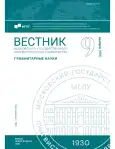Semantics Within the Mythopoetic Paradigm: Studying Lexical Semantics
- 作者: Tsvetaeva E.N.1
-
隶属关系:
- Moscow State Linguistic University
- 期: 编号 9(903) (2025)
- 页面: 98-104
- 栏目: Linguistics
- URL: https://journal-vniispk.ru/2542-2197/article/view/342125
- ID: 342125
如何引用文章
全文:
详细
The paper considers challenges arising while studying German language semantic processes determined by their relation to myth as a mode of thought and representing a corresponding set of mythologems (concepts and motives). Lexemes as well as phrasemes which articulate such lexemes comprise the data for this study, while the aim of the study is to showcase the capabilities of the mythosemantic approach to lexis description as applied to studies concerned with evolution of polysemy, syntagmatics and paradigmatics. The present study employs historical and etymological analysis as well as comparative approach in order to identify general semantic trends. Contextual analysis gives the opportunity to study the meaning of certain words at certain times throughout history meanwhile corpus analysis enables tracking of lexical change.
作者简介
Elena Tsvetaeva
Moscow State Linguistic University
编辑信件的主要联系方式.
Email: elenatsvetaeva@yandex.ru
PhD in Philology, Associate Professor, Associate Professor at the Department of Lexicology and Stylistics of German, Faculty of German
俄罗斯联邦参考
- Juvonen, P., Koptjevskaja-Tamm, M. (Eds.). (2016).The lexical typology of semantic shifts. Berlin: De Gruyter Mouton. (Cognitive Linguistics Research, 58).
- Marzo, D. (2013). Polysemie als Verfahren lexikalischer Motivation. Tubingen: Narr Verlag.
- Traugott, E. C., Dasher, R. B. (2002). Regularities in semantic change. Cambridge: Cambridge Univ. Press.
- Zalizniak, Anna A. (2018). The Catalogue of Semantic Shifts: 20 years later. Russian journal of linguistics, 22(4), 770–786.
- Sokolov, M. N. (2002). Vremja i mesto: Iskusstvo Vozrozhdenija kak pervorubezh virtual’nogo prostranstva = Time and place: Renaissance art as the frontier of virtual space. Moscow: Progress-Tradicija. (In Russ.)
- Lotman, Ju. M., Uspenskij, B. A. (2010). Mif – imja – kul’tura = Myth – name – culture. In Lotman, Ju. M. Semiosfera (pp. 525–543). St.Petersburg: Iskusstvo-SPB. (In Russ.)
- Meletinskij, E. M. (2012). Pojetika mifa = Poetics of myth. Moscow: Akademicheskij Proekt; Mir. (In Russ.)
- Kolesov, V. V. (1989). Drevnerusskij literaturnyj jazyk = Old Russian literary language. Leningrad: Leningrad State University Press. (In Russ.)
- Tsvetaeva, E. N., Pankratyeva, E. S. (2024). Formation and development of binary phrasemes in the German language. In Empirical studies of Germanic languages (pp. 141–152): proceedings of the VII Readings in memory of V.N. Yartseva. Moscow: Jazykovedenie. (In Russ.)
- Lotman, Ju. M. (2002). Literatura i mifologija = Literature and mythology. Istorija i tipologija russkoj kul’tury (pp. 727–743). St.Petersburg: Iskusstvo-SPB. (In Russ.)
- Trubachev, O. N. (2005). Trudy po jetimologii: Slovo. Istorija. Kul’tura = Works on etymology: Word. History. Culture (vol. 2): in 2 vols. Moscow: Jazyki slavjanskoj kul‘tury. (In Russ.)
- Tsvetaeva, E. N. (2013). Semantic diffusiveness of the word elend in modern German. Vestnik of Moscow State Linguistic University, 18(678), 67–72. (In Russ.)
- Gurevich, A. Ja. (2006). Izbrannye trudy. Krest’janstvo srednevekovoj Norvegii = Selected works. Peasantry of medieval Norway. St.Petersburg: Saint Petersburg University Press. (In Russ.)
补充文件










